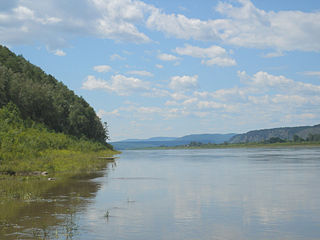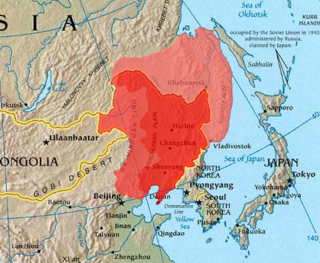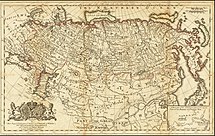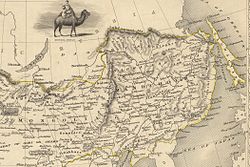
The Amur, or Heilong Jiang, is the world's tenth longest river, forming the border between the Russian Far East and Manchuria/Northeastern China. The Amur proper is 2,824 kilometres (1,755 mi) long, and has a drainage basin of 1,855,000 km2 (716,000 sq mi). Including its source river Argun, it is 4,444 km (2,761 mi) long. The largest fish species in the Amur is the kaluga, attaining a length as great as 5.6 metres (18 ft). The river basin is home to a variety of large predatory fish such as northern snakehead, Amur pike, taimen, Amur catfish, predatory carp and yellowcheek, as well as the northernmost populations of the Amur softshell turtle and Indian lotus.

Khabarovsk Krai is a federal subject of Russia. It is located in the Russian Far East and is administratively part of the Far Eastern Federal District. The administrative centre of the krai is the city of Khabarovsk, which is home to roughly half of the krai's population and the largest city in the Russian Far East. Khabarovsk Krai is the fourth-largest federal subject by area, and had a population of 1,343,869 as of 2010.

The Russian Far East is a region in Northeast Asia. It is the easternmost part of Russia and the Asian continent; and is administered as a part of the Far Eastern Federal District, which is located between Lake Baikal in eastern Siberia and the Pacific Ocean. The area's largest city is Khabarovsk, followed by Vladivostok. The region shares land borders with the countries of Mongolia, China, and North Korea to its south, as well as maritime boundaries with Japan to its southeast, and with the United States along the Bering Strait to its northeast.

The Convention of Peking or First Convention of Peking is an agreement comprising three distinct treaties concluded between the Qing dynasty of China and Great Britain, France, and the Russian Empire in 1860. In China, they are regarded as among the unequal treaties.

The Xianfeng Emperor, also known by his temple name Emperor Wenzong of Qing, personal name Yizhu, was the eighth emperor of the Qing dynasty, and the seventh Qing emperor to rule over China proper, reigned from 1850 to 1861. During his reign, the Qing dynasty experienced several wars and rebellions including the Taiping Rebellion, Nian Rebellion, and Second Opium War. He was the last Chinese emperor to exercise sole power.

The Treaty of Aigun was an 1858 treaty between the Russian Empire and the Qing dynasty that established much of the modern border between the Russian Far East and China by ceding much of Manchuria, now known as Northeast China. Negotiations began after China was threatened with war on a second front by Governor-General of the Far East Nikolay Muraviev when China was suppressing the Taiping Rebellion. It reversed the Treaty of Nerchinsk (1689) by transferring the land between the Stanovoy Range and the Amur River from the Qing dynasty to the Russian Empire. Russia received over 600,000 square kilometers (231,660 sq mi) of what became known as Outer Manchuria.

The Treaty of Nerchinsk of 1689 was the first treaty between the Tsardom of Russia and the Qing dynasty of China. The Russians gave up the area north of the Amur River as far as the Stanovoy Range and kept the area between the Argun River and Lake Baikal. This border along the Argun River and Stanovoy Range lasted until the Amur Annexation via the Treaty of Aigun in 1858 and the Convention of Peking in 1860. It opened markets for Russian goods in China, and gave Russians access to Chinese supplies and luxuries.


Outer Manchuria, sometimes called Russian Manchuria, refers to a region in Northeast Asia that is now part of the Russian Far East but historically formed part of Manchuria. While Manchuria now more normatively refers to Northeast China, it originally included areas consisting of Priamurye between the Amur River and the Stanovoy Range to the north, and Primorskaya which covered the area in the right bank of Ussuri River to the Pacific Coast. The region was ruled by a series of Chinese dynasties and the Mongol Empire, but control of the area was ceded to the Russian Empire by the Qing China during the Amur annexations in the 1858 Treaty of Aigun and 1860 Treaty of Peking, with the terms "Outer Manchuria" and "Russian Manchuria" arising after the Russian annexation. The same general area became known as Green Ukraine after a large number of settlers from Ukraine came to the region.

Green Ukraine, also known as Zelenyi Klyn or Zakytaishchyna, is a historical Ukrainian name for the land in the Russian Far East area between the Amur River and the Pacific Ocean, an area roughly corresponding to Outer Manchuria.

The Stanovoy Range is a mountain range located in the Sakha Republic and Amur Oblast, Far Eastern Federal District. It is also known as Sükebayatur and Sükhbaatar in Mongolian, or the Stanovoy Mountains or Outer Khingan Range in English. The range was first studied and scientifically described by Russian researcher Alexander von Middendorff.
Ussuri krai is an unofficial name for a part of Primorsky Krai and Khabarovsky Krai that consisted of the Ussuri and South-Ussuri Okrugs. The name was often used in the late Russian Empire. The name comes from the fact that Ussuri River is located on the territory of the krai.

Primorskaya Oblast was an administrative division of the Russian Empire and the early Russian SFSR, created on October 31, 1856 by the Governing Senate. The name of the region literally means "Maritime" or "Coastal." The region was established upon a Russian conquest of Daur people that used to live along Amur River. Before the Russian conquest of Russian Manchuria, the territory belonged to the Chinese region of Manchuria.

Count Nikolay Nikolayevich Muravyov-Amursky was a Russian general, statesman and diplomat, who played a major role in the expansion of the Russian Empire into the Amur River basin and to the shores of the Sea of Japan.
Yishan, courtesy name Jingxuan, was a Manchu lesser noble and official of the Qing dynasty. He is best known for his failure to defend Guangzhou (Canton) from British forces during the First Opium War, and for signing the treaties of Kulja and Aigun with the Russian Empire in 1851 and 1858 respectively.

The Sino-Russian border conflicts (1652–1689) were a series of intermittent skirmishes between the Qing dynasty of China, with assistance from the Joseon dynasty of Korea, and the Tsardom of Russia by the Cossacks in which the latter tried and failed to gain the land north of the Amur River with disputes over the Amur region. The hostilities culminated in the Qing siege of the Cossack fort of Albazin in 1686 and resulted in the Treaty of Nerchinsk in 1689 which gave the land to China.

The Muravyov-Amursky Peninsula is a peninsula in Primorsky Krai, Russia, located in the Peter the Great Gulf of the Sea of Japan. Vladivostok, the administrative center of Primorsky Krai, is located on the southern tip of the peninsula.

Imperial Russia was a participant of the Chinese Opium Wars, more specifically in the second and third wars which occurred in 1856-1860. Russia played a role of mediator, being both an ally with Britain, France, and the United States and negotiator with the elites of the Qing dynasty. Throughout the whole war period Russia provided minimal amount of military aid and used diplomatic power to present its interests in the conflict. As a result of the ratified agreements in 1860 Russia received former Manchurian lands along the Ussuri river and increased its economical influence on China.
Events from the year 1858 in China.

The Amur Oblast with the center in Blagoveshchensk was formed on December 20, 1858 by the Personal Decree No. 33862. By this Decree, on the proposal of the Governor–General of Eastern Siberia and the Siberian Committee, the Amur Region was made up of lands "located on the left bank of the Amur River, starting from the junction of the Shilka and Argun Rivers or from the borders of the Trans–Baikal and Yakutsk Oblasts, along the entire course of the Amur, to the mouth of the river Ussuri and to the new border of the Primorsky Oblast".



















